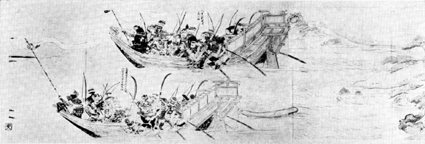HAKATA Bay
In CHIKUZEN - MOKU-SHURAI - "The
Invasion of the Mongols"
KAMIKAZE
"The Divine Wind"
On August 15, 1281,
KAMEYAMA-JOKO, the retired father of Emperor
GO-UDA, appeared before AMATERASU "The Divine
Goddess of the Sun" in ISE asking her intervention
on behalf of Japan.

900 Korean ships with
10,000 infantry and 17,000 sailors had ferried
15,000 Chinese and Mongol troops to rendezvous at
IKI Island with the 3,500 ship Chinese "Yang-tze"
task-force of 60,000 navy carrying 100,000
soldiers to conquer the Land of the Gods.
Six and half years before, the 150 ship first
invasion had thrashed against the coast in a
storming November night to the loss of 13,000
lives.

This was
summer - the well-planned, long awaited
summer.
A sea of angry boats and garish streamers imposed
hideous clarity to the excited echoes of drums and
horn, - filtering over the flat, naked water.
The Japanese had prepared six and half years. HOJO
TOKIMUNE's coordinated national muster stood ready
but outnumbered on its fifteen foot, 25 mile wall
protecting HAKATA from the waves and this vast
spectacle painted across everyone's eyes.
Moving effortlessly from the horizon, a small
black dot appeared in the cloudless sky. -
Searching a station just above the throng, it
stretched dark fingers without wait.
A huge and deafening still swallowed their noisy
clamor as the ocean and its ships began to leap in
eerie silence.
Then the leaves started rattling...
Foretelling the deep growl that shook trees before
its violent thunder hit with howling rage. Flags
were pulled from standards. And warriors clung for
the moaning earth - just to
watch.
Careening ships were pitched on crags or dragged
away. Swamped wrecks rolled over, and over each
other in the boiling sea;
-
grinding their vessels to splinter wood.
The sight made men drunk, some sat numb.
That day, the Hand of God labored for the Japanese
just as it had for Moses at the Red Sea.
AMATERASU allowed three lives to return the news
to Kublai-Khan.
|
